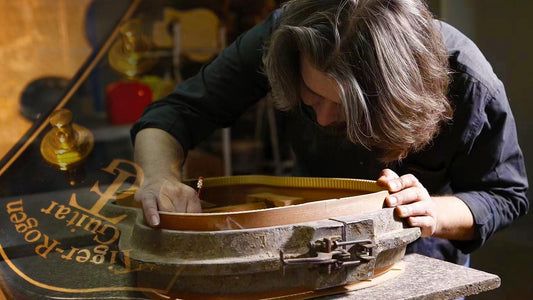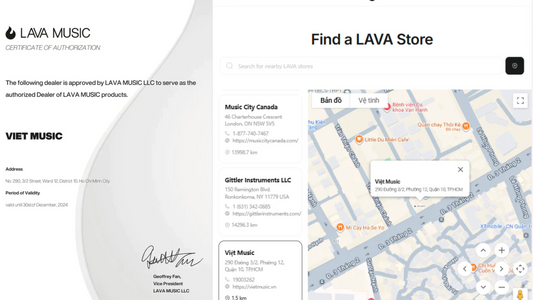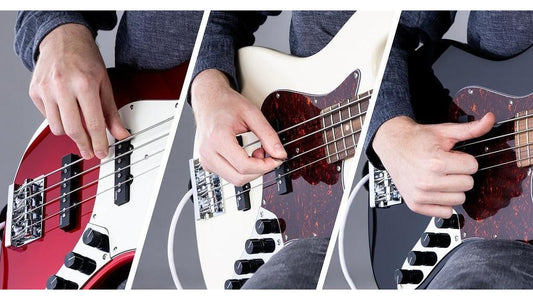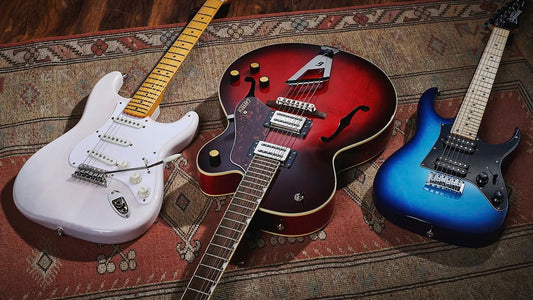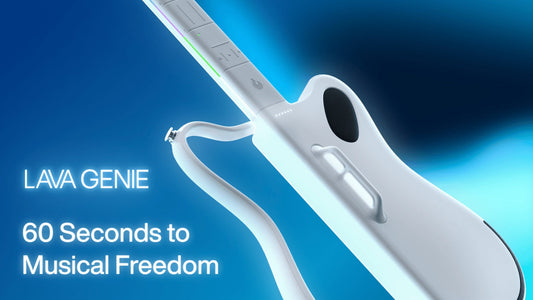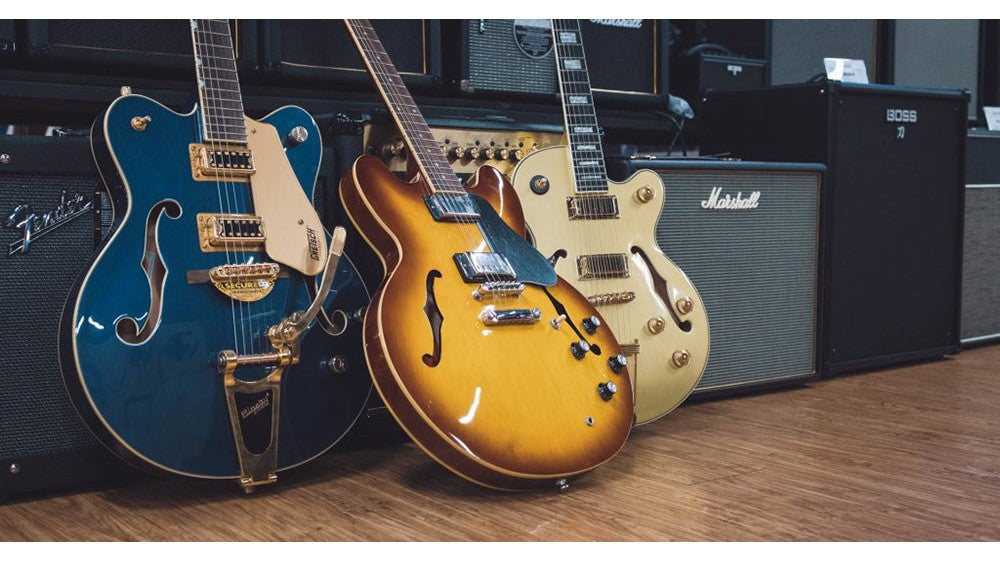
Guitar Hollybody và Semi Hollybody
Hollowbody có vẻ là một thuật ngữ xa lạ khi bạn mới bước vào thế giới đàn guitar. Thân đàn hollow là gì? Bạn nghĩ rằng mọi cây guitar đều có thân đàn solid? Hollowbody khác gì với semi-hollow? Đừng lo, chúng tôi sẽ giải thích mọi thứ cho bạn thông qua bài viết ngắn gọn này về những cây guitar thân đàn hollow và semi-hollow.
Có lẽ bạn sẽ ngạc nhiên nhưng chúng tôi tin rằng bạn đã từng nghe về thân đàn hollow, về guitar semi-acoustic hoặc thinline cũng như những thuật ngữ ít phổ biến hơn (và thiếu chính xác) như thân đàn archtop electric, electro-acoustic, jazz box, và thân đàn nhiều ngăn. Kể từ khi nó xuất hiện vào những năm 1930, thân đàn hollow đã thống trị sân khấu âm nhạc và điều này cũng đúng với semi-hollowbody. Tất cả mọi người, từ The Beatles đến Jack White đều chơi những nhạc cụ này, dĩ nhiên chúng ta cũng không quên nhắc đến mẫu semi-hollow “Lucille” của nghệ sĩ nhạc blues B.B King.
Với nhiều nghệ sĩ đầy đam mê với nhiều thể loại âm nhạc , rõ ràng là guitar thân hollow và semi-hollow đã tạo nên được vị thế riêng cho mình. Thậm chí ngay cả khi các công ty đang liên tục cho ra những mẫu solidbody này đến solidbody khác, thì một khoản đầu tư lớn của hãng R&D vẫn được rót vào để thúc đẩy sự phát triển của guitar semi-acoustic. Có lẽ bạn đang nghĩ những cây guitar này có điều gì đó rất đặc biệt phải không? Bạn đúng rồi đấy. Nhưng điều đó là gì? Bài viết này sẽ giải đáp những thắc mắc này cho bạn.
Lịch sử hình thành
Thân đàn Hollow
Chúng ta không thể hiểu sâu về một điều gì đó mà không nhìn lịch sử mà nó hình thành và phát triển. Đối với thân đàn guitar hollow cũng vậy, nó sẽ đưa chúng ta trở lại thời kỳ hoàng kim của nhạc jazz nơi mà các ban nhạc lớn đang rất thành công. Họ không muốn tiếng guitar bị chìm trong tiếng hò hét của đám đông. Dù pickup đã tồn tại nhưng việc khuếch đại âm thanh của những cây acoustic vẫn là một nhiệm vụ khó nhằn. George Buchamp của Rickenbacker và nghệ sĩ chơi nhạc điện tử người Tây Ban Nha Ken Roberts đã tạo nên một sự bùng nổ với mẫu acoustic phong cách concert bằng gỗ laminate mahogany, đây cũng là mẫu guitar signature đầu tiên của công ty. Nó thực sự là một nhạc cụ tiên phong trong lĩnh vực guitar điện.

Không lâu sau đó, Gibson tham gia cuộc thi với model ES-150 của họ. Trước đó, Guy Hart đã thiết kế một pickup dạng thanh cho các mẫu lapsteel của công ty, điều này nghĩa là họ đã có ý định điện hoá đàn guitar. Tất cả mọi người đã bị đổ gục trước mẫu ES-150. Âm thanh lớn và rõ nét của nó bắt kịp những chiếc kèn loa bằng đồng. Một điều quan trọng không kém là tay guitar cực kỳ nổi tiếng Charlie Christian cũng đã sở hữu một cây guitar như vậy và đạt nhiều thành công với mẫu guitar này.
Thân đàn Semi-hollow
Đầu những năm 1940 thì guitar điện với thân hollow là mẫu guitar cực hot mà ai cũng mong muốn sở hữu. Không chỉ vì mẫu mã phù hợp để chơi nhạc jazz mà còn là vì nhiều người cũng bắt đầu tò mò, khám phá những thể loại nhạc khác với siêu phẩm này. Tuy nhiên, vào thời điểm đó thì guitar semi-hollowbody chỉ mới bắt đầu hành trình của mình. “The Log” của Les Paul được chế tác vào năm 1939 là mẫu guitar đầu tiên được đưa ra thị trường. Nó có tên như vậy vì đó thực sự là một khúc gỗ 4×4 đặt dọc giữa thân đàn. Dù nặng hơn thân đàn hollow thông thường nhưng khối gỗ trung tâm đã đảm bảo nó không xuất hiện những vết nứt mà Les Paul không ưa. The Log cũng là nhạc cụ tiên phong trong lĩnh vực này. Và cũng như những nhạc cụ tiên phong khác, nó vượt trội hơn so với thời đại tồn tại của nó. Khi được Les Paul mang ra giới thiệu với Gibson thì “The Log” đã bị chế nhạo và từ chối.
Nhưng rồi họ đã thay đổi suy nghĩ của mình vào những năm 1950 khi đàn guitar electric thân solid đầu tiên được tung ra thị trường. Broadcaster đã thay đổi cuộc chơi, và Gibson nhận ra rằng họ phải làm điều gì đó quyết liệt nếu muốn cạnh tranh. Ted McCarty nhớ ra The Log và sử dụng nó làm nguyên mẫu. Cue ES-335, hợp nhất giữa độ ấm và cộng hưởng của thân rỗng với khả năng chống phản âm. 16 năm sau, The Log cuối cùng cũng có ngày xuất hiện, mặc dù ở dạng được tái tạo lại. ES-335 của Gibson giờ đây đã trở thành hiện tượng văn hoá. Các nhạc sĩ đổ xô tìm mua và nhiều thương hiệu khác cũng bắt đầu sản xuất những mẫu semi-hollow của riêng mình. Từ đó về sau, thân đàn hollow và semihollow là một phần tất yếu của thị trường.

Tim hiểu chi tiết về từng dáng đàn
Hollowbody
Cấu tạo: Một số người lầm tưởng rằng hollowbody chỉ là một cây guitar acoustic nhưng được gắn thêm các pickup. Khác với semi-hollow, đúng là những mẫu hollowbody thực sự gần giống với guitar acoustic nhưng giữa chúng cũng có những khác biệt. Một cây guitar hollowbody không phải là một khối gỗ và đúng vậy, hollowbody nhẹ hơn solidbody.
Bên cạnh đặc điểm rõ nét này, hollowbody cũng đa dạng như những loại guitar khác. Ví dụ như vibrato tailpiece, ngựa đàn có thể điều chỉnh và cần đàn gắn vào thân ở phím cao hơn so với các mẫu acoustic. Nhiều guitar hollowbody cũng có mặt trước cong hình vòm trái ngược với mặt trước phẳng của đàn acoustic. Do vậy, hollowbody thường không có lỗ thoát âm tròn tiêu chuẩn ở giữa đàn mà thay vào đó là lỗ F hoặc các lỗ thoát âm được khoét nông.
Theo thiết kế, vài mẫu hollowbody có thể mỏng như guitar electric solidbody. Chắc chắn, những model đầu tiên này là những cây acoustic với mặt trước cong và có các pickup của Charlie Christian, ví dụ như mẫu Gibson L-50. Đó là những cây guitar nặng với cần đàn kiểu chữ V. Đương nhiên, các phiên bản kiểu dáng đẹp hơn sẽ sớm xuất hiện ngay sau đó,ví dụ như kiểu thân single và double cut với cần đàn nông hơn như Epiphone Casino.
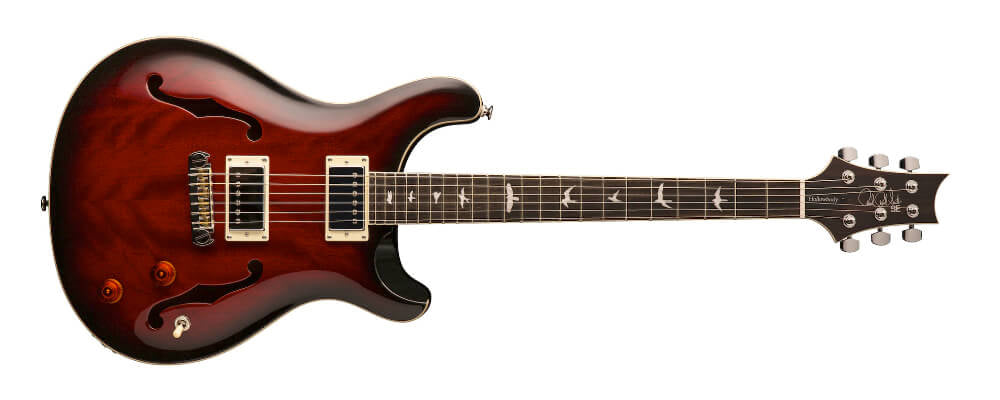
Chất âm: Thành thật mà nói, âm thanh của một cây guitar hiếm khi xuất phát từ một yếu tố duy nhất. Cấu tạo, dây đàn và gỗ tonewood có sức ảnh hưởng lớn đến âm thanh của đàn. Tuy vậy, những mẫu guitar hollowbody có các tiêu chuẩn âm sắc riêng..
Đối với người mới bắt đầu, dải midrange của hollowbody có khuynh hướng tập trung và cộng hưởng hơn so với một cây acoustic. Và từ nguồn gốc của nó ta cũng nhận thấy nó có thể có nhiều chất âm khác nhau. Thật thú vị, là hollowbody thường được xem là một cây guitar để luyện tập nhờ đặc điểm “im lặng” của nó khi bạn chơi đàn nhưng không cắm dây. Nó không phát ra âm thanh lớn như những cây acoustic nhưng vẫn có âm lượng đủ nghe.
So với solidbody, âm thanh của hollowbody ấm hơn và tròn trịa hơn, đặc biệt là ở low end thấp hơn. Các âm vực cao cũng sẽ khá sáng nhưng hiếm khi đạt đến độ cao như thuỷ tinh của solidbody. Feedback cũng là một điều bạn cần cân nhắc, đặc biệt khi bạn chơi ở mức âm lượng và gain level cao.
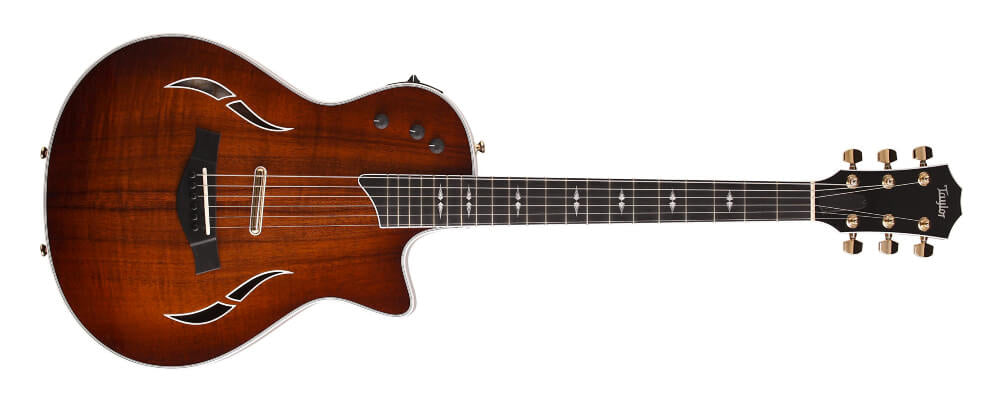
Semi-Hollowbody
Cấu tạo: Nếu bạn còn nhớ thì guitar semi-hollow được chế tác để trực tiếp cạnh tranh với solidbody, do đó chúng có nhiều đặc điểm khá giống nhau. Phần eo thắt vừa vặn, hiếm khi sâu hơn 3 inch và và trọng lượng nhẹ. Nhưng điểm đặc biệt ở mẫu guitar này và tách biệt nó khỏi hollowbody là phần centre block. Tùy thuộc vào thương hiệu và model mà có vô số phong cách và kiểu dáng trên thị trường. Những model cũ hơn từng có thân hollow và gắn vào một tấm gỗ 2×4. Ngày nay, các nhà sản xuất đã loại bỏ hẳn centre block khỏi thân đàn.
Giống như chúng tôi đã nói trước đó, không có một chuẩn mực nào để đặt centre block trên thân đàn. Đôi khi, nó chiếm toàn bộ chiều dài của thân đàn, đôi khi nó chỉ nằm ở phần ngựa đàn, lúc khác thì các nhà thiết kế chia thành các khối nhỏ để củng cố chất âm của guitar. Vì vậy mà nó trở thành một thuộc tính được cá nhân hóa cao. . Cũng như hollowbody, có nhiều loại semi-hollow. Các mẫu semi-hollow truyền thống có mặt cần rộng, phẳng và mặt lưng cong. Sau này xuất hiện thêm các phiên bản được tân trang lại, bắt chước khả năng chơi của solidbody mà không làm mất đi sự cộng hưởng.
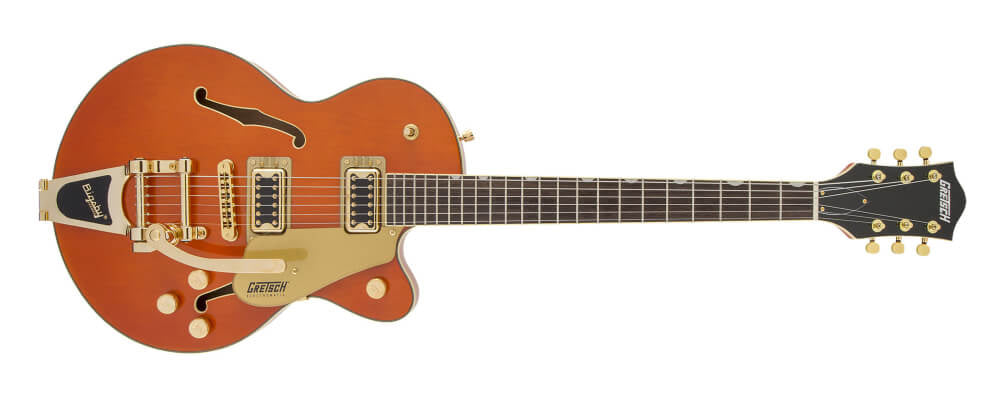
Chất âm: Khối gỗ ở giữa của semi-hollow thực hiện một nhiệm vụ quan trọng là khử feedback. Bạn có thể đã nhớ ra là guitar hollowbody có khuynh hướng gặp vấn đề feedback. Điều đó không đáng lo ngại nếu nói về semi-hollow. Thậm chí khi ở mức âm lượng và gain lớn nhất thì khối gỗ ở giữa đó sẽ giảm thiểu các rung động giao cảm. Nếu bạn không thể cưỡng lại overdrive, distortion hay fuzz thì đây quả là điều tuyệt vời.
Mặc dù ngăn được feedback nhưng thật khó để xác định chất âm của một cây guitar semi-hollow mà không cần xem xét các yếu tố liên quan. Mỗi cây guitar đều khác biệt. Một số tạo ra âm sắc không thể phân biệt được với solidbody, trong khi số khác thì có nghe khá giống âm sắc của hollowbody. Một lần nữa, nó phụ thuộc vào cấu tạo, dây đàn, và nhiều thứ khác.
Nhưng nếu chúng ta phải khái quát, thì semi-hollowbody theo bước hollowbody theo nhiều cách khác nhau. Nó không cộng hưởng như những cây acoustic nhưng vẫn có âm lượng lớn hơn so với solidbody. Khi bạn vặn âm lượng lớn hơn, semi-hollow có âm sắc rõ nét và sắc hơn so với hollowbody nhờ khối gỗ ở giữa ngăn feedback. Nhờ đó có thể bạn sẽ thấy các pickup alnico bốc lửa được gắn trên những cây semi-hollow.
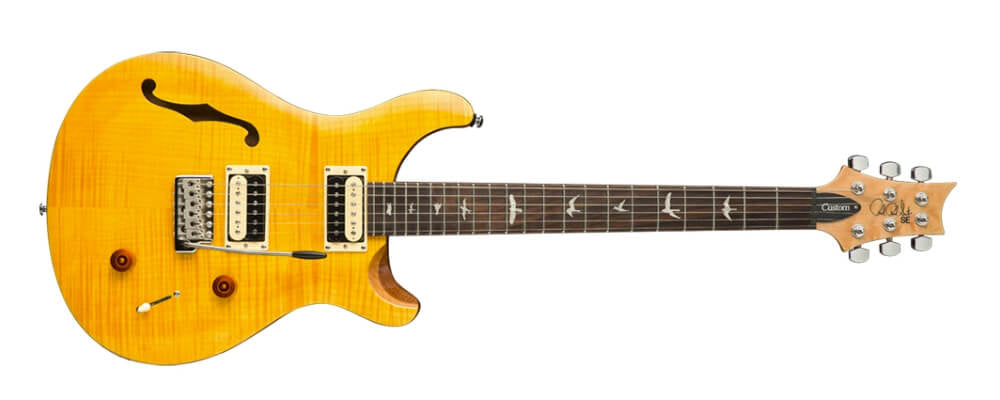
Dù có thể khá retro nhưng hollow và semi-hollow có chỗ đứng trong thế giới guitar vì nhiều lý do đặc biệt. Bạn có thể nói rằng đó là nhờ tính linh hoạt vượt thời gian, hoài niệm âm sắc xưa cũ hoặc tính thẩm mỹ cổ điển. Sức hấp dẫn khó nắm bắt là một phần nét quyến rũ không thể khước từ của những mẫu guitar này. Và điều đó, đã làm cho hollowbody và semi-hollowbody ngày càng được đón nhận nhiều hơn.
Xem thêm:
